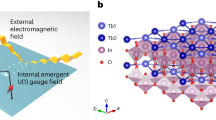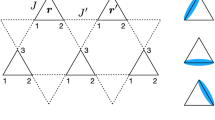Abstract
In condensed-matter physics, Mott insulators are an important phase involving strongly interacting electrons because of their intricate relationship with high-temperature superconductors1,2. Mott phases were recently observed for both bosonic and fermionic species in atomic systems3,4,5,6,7,8,9. However, in the solid state, the fingerprint of a Mott insulator implemented with bosons has yet to be found. Here we demonstrate such signature by exploring the Bose–Hubbard model using semiconductor excitons confined in a two-dimensional lattice. We emphasize the regime where on-site interactions are comparable to the energy separation between lattice-confined states. We then observe that a Mott phase is accessible, with at most two excitons uniformly occupying each lattice site. The technology introduced here allows us to programme the geometry of the lattice that confines the excitons. This versatility, combined with the long-range nature of dipolar interactions between excitons, provides a route to explore many-body phases that spontaneously break the lattice symmetry10,11.
This is a preview of subscription content, access via your institution
Access options
Access Nature and 54 other Nature Portfolio journals
Get Nature+, our best-value online-access subscription
$29.99 / 30 days
cancel any time
Subscribe to this journal
Receive 12 print issues and online access
$209.00 per year
only $17.42 per issue
Buy this article
- Purchase on Springer Link
- Instant access to full article PDF
Prices may be subject to local taxes which are calculated during checkout




Similar content being viewed by others
Data availability
Source data are provided with this paper.
References
Lee, P. A., Nagaosa, N. & Wen, X.-G. Doping a Mott insulator: physics of high-temperature superconductivity. Rev. Mod. Phys. 78, 17 (2006).
Gebhard, F. The Mott Metal-Insulator Transition (Springer, 1997).
Greiner, M., Mandel, O., Esslinger, T., Haensch, T. W. & Bloch, I. Quantum phase transition from a superfluid to a Mott insulator in a gas of ultracold atoms. Nature 415, 39–44 (2002).
Gemelke, N., Zhang, X., Hung, C. L. & Chin, C. In situ observation of incompressible Mott-insulating domains in ultracold atomic gases. Nature 460, 995–998 (2009).
Bakr, W. S. et al. Probing the superfluid-to-Mott insulator transition at the single-atom level. Science 329, 547–550 (2010).
Sherson, J. et al. Single-atom-resolved fluorescence imaging of an atomic Mott insulator. Nature 467, 68–72 (2010).
Jordens, R., Strohmaier, N., Guenter, K., Moritz, H. & Esslinger, T. A Mott insulator of fermionic atoms in an optical lattice. Nature 455, 204–207 (2008).
Schneider, U. et al. Metallic and insulating phases of repulsively interacting fermions in a 3D optical lattice. Science 322, 1520–1525 (2010).
Greif, D. et al. Site-resolved imaging of a fermionic Mott insulator. Science 351, 953–957 (2016).
Dutta, O. et al. Non-standard Hubbard models in optical lattices: a review. Rep. Prog. Phys. 78, 066001 (2015).
Baranov, M. A., Dalmonte, M., Pupillo, G. & Zoller, P. Condensed matter theory of dipolar quantum gases. Chem. Rev. 112, 5012–5061 (2012).
Salomon, C. et al. (eds) Many-Body Physics with Ultracold Gases: Lecture Notes of the Les Houches Summer School (Oxford Scholarship, 2010).
Cao, Y. et al. Correlated insulator behaviour at half-filling in magic-angle graphene superlattices. Nature 556, 80–84 (2018).
Shimazaki, Y. et al. Strongly correlated electrons and hybrid excitons in a moiré heterostructure. Nature 580, 472–477 (2020).
Tang, Y. et al. Simulation of Hubbard model physics in WSe2/WS2 moiré superlattices. Nature 579, 353–358 (2020).
Regan, E. C. et al. Mott and generalized Wigner crystal states in WSe2/WS2 moiré superlattices. Nature 579, 359–363 (2020).
Moses, S. et al. New frontiers for quantum gases of polar molecules. Nat. Phys. 13, 13–20 (2017).
Goral, K., Santos, L. & Lewenstein, M. Quantum phases of dipolar bosons in optical lattices. Phys. Rev. Lett. 88, 170406 (2002).
Trefzger, C., Menotti, C., Capogrosso-Sansone, B. & Lewenstein, M. Ultracold dipolar gases in optical lattices. J. Phys. B: . Mol. Opt. Phys. 44, 193001 (2010).
Baier, S. et al. Extended Bose-Hubbard models with ultracold magnetic atoms. Science 352, 201–205 (2016).
Larson, J., Collin, A. & Martikainen, J.-P. Multiband bosons in optical lattices. Phys. Rev. A 79, 033603 (2009).
Mark, M. J. et al. Precision measurements on a tunable Mott insulator of ultracold atoms. Phys. Rev. Lett. 107, 175301 (2011).
Seyler, K. L. et al. Signatures of moiré-trapped valley excitons in MoSe2/WSe2 heterobilayers. Nature 567, 66–70 (2019).
Tran, K. et al. Evidence for moiré excitons in van der Waals heterostructures. Nature 567, 71–75 (2019).
Jin, C. et al. Observation of moiré excitons in WSe2/WS2 heterostructure superlattices. Nature 567, 76–80 (2019).
Alexeev, E. M. et al. Resonantly hybridized excitons in moiré superlattices in van der Waals heterostructures. Nature 567, 81–86 (2019).
Combescot, M., Combescot, R. & Dubin, F. Bose–Einstein condensation of indirect excitons: a review. Rep. Prog. Phys. 80, 066401 (2017).
Lagoin, C. et al. Microscopic lattice for two-dimensional dipolar excitons. Phys. Rev. B 102, 245428 (2020).
Lagoin, C. et al. Quasicondensation of bilayer excitons in a periodic potential. Phys. Rev. Lett. 126, 067404 (2021).
High, A. A. et al. Trapping indirect excitons in a GaAs quantum-well structure with a diamond-shaped electrostatic trap. Phys. Rev. Lett. 103, 087403 (2009).
Grosso, G. et al. Excitonic switches operating at around 100 K. Nat. Photon. 3, 577–580 (2009).
Winbow, A. G. et al. Electrostatic conveyer for excitons. Phys. Rev. Lett. 106, 196806 (2011).
Rosenberg, I., Mazuz-Harpaz, Y., Rapaport, R., West, K. & Pfeiffer, L. Electrically controlled mutual interactions of flying waveguide dipolaritons. Phys. Rev. B 93, 195151 (2016).
Schinner, G. J. et al. Confinement and interaction of single indirect excitons in a voltage-controlled trap formed inside double InGaAs quantum wells. Phys. Rev. Lett. 110, 127403 (2013).
Mahmud, K. W. et al. Finite-temperature study of bosons in a two-dimensional optical lattice. Phys. Rev. B 84, 054302 (2011).
Ivanov, A. L. Thermalization and photoluminescence dynamics of indirect excitons at low bath temperatures. J. Phys. Condens. Matter 16, S3629 (2004).
Beian, M. et al. Spectroscopic signatures for the dark Bose-Einstein condensation of spatially indirect excitons. EuroPhys. Lett. 119, 37004 (2017).
Mott, N. Conduction in glasses containing transition metal ions. J. Non Cryst. Solids 1, 1–17 (1968).
Capogrosso-Sansone, B., Trefzger, C., Lewenstein, M., Zoller, P. & Pupillo, G. Quantum phases of cold polar molecules in 2D optical lattices. Phys. Rev. Lett. 104, 125301 (2010).
Acknowledgements
We would like to thank M. Holzmann for his crucial support in calculating microscopically dipolar interactions in the lattice, M. Lewenstein, M. Polini and A. Reserbat-Plantey for a critical reading of our manuscript, together with S. Gasparetto for graphical works. F.D. and C.L. acknowledge the Labex Matisse and IXTASE from the French Agency for Research (ANR-20-CE30-0032-01). The work at Princeton University (L.P. and K.B.) was funded by the Gordon and Betty Moore Foundation through the EPiQS initiative Grant GBMF4420 and by the National Science Foundation MRSEC Grant DMR 1420541.
Author information
Authors and Affiliations
Contributions
L.P. and K.B. realized the bare semiconductor quantum wells on which C.L., S.S. and F.D. realized the electronic lithography necessary to engineer the final sample with electrostatic lattices. C.L. and F.D. performed the experiments on this sample, analysed the results and wrote the manuscript. F.D. designed the project.
Corresponding author
Ethics declarations
Competing interests
The authors declare no competing interests.
Additional information
Peer review information Nature Physics thanks the anonymous reviewers for their contribution to the peer review of this work.
Publisher’s note Springer Nature remains neutral with regard to jurisdictional claims in published maps and institutional affiliations.
Supplementary information
Supplementary Information
Supplementary Figs. S1–S12, Tables 1 and 2 and Sections I to V.
Source data
Source Data Fig. 2
Raw experimental data for all panels of Fig 2.
Source Data Fig. 3
Raw experimental data for all panels of Fig 3.
Source Data Fig. 4
Raw experimental data for all panels of Fig 4.
Rights and permissions
About this article
Cite this article
Lagoin, C., Suffit, S., Baldwin, K. et al. Mott insulator of strongly interacting two-dimensional semiconductor excitons. Nat. Phys. 18, 149–153 (2022). https://doi.org/10.1038/s41567-021-01440-8
Received:
Accepted:
Published:
Issue Date:
DOI: https://doi.org/10.1038/s41567-021-01440-8
This article is cited by
-
Valley-polarized excitonic Mott insulator in WS2/WSe2 moiré superlattice
Nature Physics (2024)
-
When excitons crystallize
Nature Physics (2024)
-
Exciton density waves in Coulomb-coupled dual moiré lattices
Nature Materials (2023)
-
Dipole ladders with large Hubbard interaction in a moiré exciton lattice
Nature Physics (2023)
-
Dual-density waves with neutral and charged dipolar excitons of GaAs bilayers
Nature Materials (2022)



